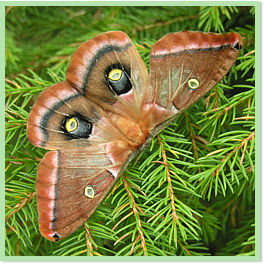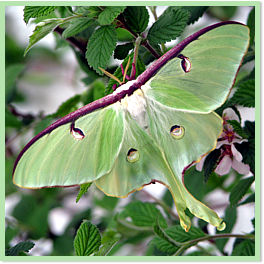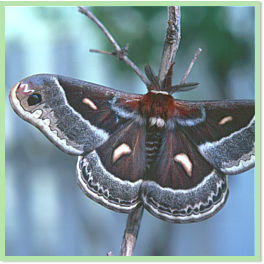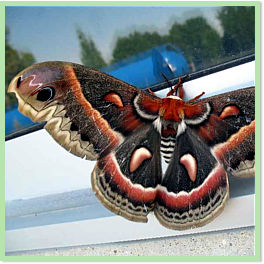
A Guide to the Giant Silk Moths of Manitoba
Polyphemus Moth | Luna Moth | Columbia Silk Moth | Cecropia Moth
|
Polyphemus Moth (Antheraea polyphemus)
Wing-span: 10-15 cmRange: Southern and central Manitoba (at least), usually in forested areas. Common in Winnipeg and other cities.
Distinguishing features: Overall brown to beige colouring with large, clear "eye-spots" on hind wing.
Host plants: Wide range of trees and shrubs including: elm, ash, maple, willow and birch. Where paper birch is available this seems to be a favourite food.
Caterpillar: Bright lime green, somewhat translucent, with a row of vertical silvery/yellow stripes down the side. Grows to a length of about 7 cm and nearly 2 cm in width.
Cocoon: Oval shaped, usually spun with leaves in outer layer, attached to shrub or tree branches. The silk is white.
Wing-span: 8-12 cmRange: Southern and central Manitoba (at least), usually in forested areas.
Distinguishing features: Bright green coloration with long "tails" on hind wings.
Host plants: Wide range of trees and shrubs including: alder, willow, cherries (Prunus sp.) and birch. Paper birch seems to be a favourite food.
Caterpillar: Bright lime green, somewhat translucent, with a row of pink or brown spots down the side and numerous small bristles on top. Grows to a length of about 7 cm and nearly 2 cm in width.
Cocoon: Oval shaped, usually spun with leaves in outer layer. The silk is light brown. Often falls to forest floor.
Columbia Silk moth (Hyalophora columbia)
Wing-span: 8-10 cmRange: Southern Manitoba, in forested areas.
Distinguishing features: Similar to the Cecropia, but usually smaller and drabber in colour, lacking a red band in the hind wing.
Host plants: Tamarack trees are a known host plant in eastern North America. Eats a variety of trees and shurbs in Manitoba including alders and birch.
Caterpillar: Dull waxy green, not translucent, with rows of orange, yellow or blue tubercles along the top and sides. Grows to a length of about 7 cm and nearly 2 cm in width.
Cocoon: Spindle shaped, attached lengthwise to twigs on shrub or tree branches. The silk is brown with prominent silvery hairs.
Cecropia Moth (Hyalophora cecropia)
Wing-span: 11-15 cmRange: Not widespread, but occurring in pockets of habitat in Southern Manitoba.
Distinguishing features: Similar to the Columbia, but usually larger and brighter in colour, with a definite red band in the hind wing.
Host plants: Wide range of trees and shrubs including: elm, ash, maple, willow, cherries (Prunus sp.) and birch.
Caterpillar: Dull waxy green, not translucent, with rows of orange, yellow or blue tubercles along the top and sides. Grows to a length of about 9 cm and nearly 2.5 cm in width.
Cocoon: Spindle shaped, attached lengthwise to twigs on shrub or tree branches. The silk is brown.
Thanks for learning about Giant Silk Moths! Bye for now.
Check out: Giant Silk Moths in the Classroom.
| You can help NatureNorth produce more great articles with a secure donation through PayPal. Our Google Adsense ads pay our server costs, but that's about it. To learn more follow this link: Support NatureNorth. Thank-you! | |
Return to: Spring Issue | NatureNorth Front page




